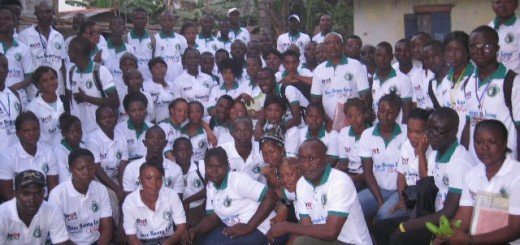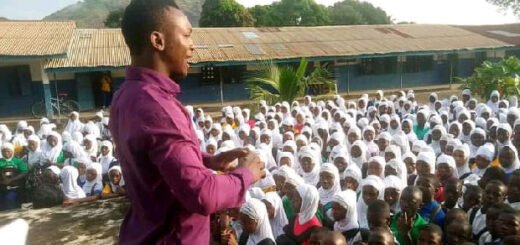Community tree planting nursery in Oku – FIOH Co-operative
Nursery Development for Environmental Education and Forest Regeneration in Oku
 In 2014 the FIOH Fund provided grants of £500 each for community tree planting to two non-government organisations with offices based in Oku on the edge of Kilum Ijim natural forest, in the NW Region of Cameroon:
In 2014 the FIOH Fund provided grants of £500 each for community tree planting to two non-government organisations with offices based in Oku on the edge of Kilum Ijim natural forest, in the NW Region of Cameroon:
- Cameroon Gender and Environment Watch (CAMGEW) and
- Future in Our Hands Womens Co-operative, Oku
This report was prepared by the FIOH Oku co-operative leader, Gangli Mary Nkeng.
1. Presentation of FIOH-Oku and the current project
Future In Our Hands Cooperative is a women’s farming cooperative made up of over 5 Common Initiative Groups (CIGs) representing over five villages in Oku Subdivision. It was created on the 22nd of September 1999. It encourages the spirit of hard work, cooperation and togetherness in women. It is called a women’s cooperative because 95% of members are women. Her creation was thanks to the interest SHUMAS NGO and Future Our Hands–Oku had to empower women and the vulnerable in the Oku community. It has as its motto: educate a man, educate an individual; educate a woman to educate a whole nation. This is because of the socio-economic importance of a woman in the purely African village community like Oku. Since its creation FIOH-Oku has realised the following projects (just summaries):
- Improving the processing and transformation of corn and cassava through mills and haulers donated by SHUMAS and her partners.
- Offering loans to members at very minimal interest rates through a scheme developed by SHUMAS.
- Through SHUMAS there has been the development of community health infrastructure for the village of Lui.
- Regular production of organic food crops and other natural products for income generation and food security.
- Attending agro-pastoral shows to market their produce.
- Training and practising sustainable and integrated farming and livestock productions methods amongst her members.
- Training and application of agroforestry techniques to her membership.
In 2014, FIOH-Oku received a grant of £500 pounds from Michael Thomas of FIOH Fund-UK to develop a nursery of indigenous trees. We developed two nurseries with the funds, one of 3,000 indigenous trees in 2014 and another of 3,500 indigenous trees in 2015.
2. Presentation of the project area
Oku is located in Bui Division of the North West Region of Cameroon. It is made up of 36 village communities mostly living along the slopes of the Kilum Mountain. The people depend mostly on forest resources, subsistence agriculture, cash crop farming, livestock production and local artisan work for their livelihood. The Kilum Ijim Forest found in the community is a naturally preserved moist montane forest with a surface area of about 20,000 hectares. It is located in the Mount Oku Ridge in the Bamenda Highlands and forms part of the High Plateaus Agro-ecological Zone of Cameroon. The geographic location of the area is latitude 6°07’N – 6°17’N and longitude 10°20’E – 10°25’E. It has very important and threatened Afro-Montane endemic animal and plant species such as Prunus africana amongst others. It is an internationally important biodiversity hotspot and a critical zone for carbon sequestration within the High Plateaus Agro-ecological Zone.
The Kilum area is one of the most highly populated locations in Africa and Cameroon in particular, accommodating 144,800 people occupying about 328 km2 (439.3persons/km2); hence, high pressure on resources is inevitable. There has been progressive deforestation and degradation mainly due to agricultural expansion, forest fire and overgrazing. Fuel wood harvesting has also been a major cause of deforestation and forest degradation. The late 1980s decline in coffee prices triggered many farmers to migrate further up the slopes in search of new land to increase income through alternative crops.
3. Project goal and activities
The project goal was to train community members on agroforestry techniques which are soil conserving, fight poverty and hunger and to establish a nursery of indigenous trees for planting in farms and the community forests.
The objective was to offer practical agroforestry skills to at least 50 persons including men, women and children and to enable the participants to set up a nursery composed of indigenous trees for out planting within the community.
4. Project activities
Planning meeting:
After the FIOH Cameroon Network seminar and workshop held on May, 10th 2014 at SHUMAS Head Office Bamenda, FIOH-Oku had a planning meeting on May, 16th whose objective was:
- To report on the conduct of the seminar
- Present to FIOH members the cash gift given by Mike Thomas from FIOH-UK to enable members to nurse and plant indigenous trees
- Plan on when to start work on the project.
Collections of seeds and seedlings:
 On the 29th of May we met to plan on how to get sticks of the nursery fence. It was agreed that each member was to provide five sticks and men in addition will help make the fence. We equally planned on the collection of seeds and young seedlings for the nursery. We agreed to collect from the forest and from our farms. We equally decided to involve school children. The president was assigned to contact the head teacher of the school which she did.
On the 29th of May we met to plan on how to get sticks of the nursery fence. It was agreed that each member was to provide five sticks and men in addition will help make the fence. We equally planned on the collection of seeds and young seedlings for the nursery. We agreed to collect from the forest and from our farms. We equally decided to involve school children. The president was assigned to contact the head teacher of the school which she did.
Clearing, tilling and fencing of the nursery site:
The men did the clearing while the women did the tilling. This activity took place in the month of July, 2014.
Formation of nursery beds and nursing of seeds and seedlings:
Formation of beds and planting proper took place in July. Before nursing and planting the school children were taught by their teachers on the spot about the importance of trees to man and nature. The names of the trees in the Oku language were also made known to them. The planting was done with the children and their teacher. They were given some money for food and transport.
Weeding and monitoring of nursery:
Since the cooperative is made up of CIGs, the work was divided into groups and each group had a given task for weeding and monitoring. We jointly sold the young trees to CAMGEW for the sum of 178,000 CFA.
5. Detailed methodology and activities used during the project
We had a planning meeting with our members. Participants were trained by-doing in the field (a small demonstration plot we had at Manchok-Oku) on agroforestry nursery development using many locally sustainable approaches easily understood by the community. They were also trained on the importance of organic manure (compost) and how to produce organic pesticides. Lessons were given on the importance of trees in their farms, the advantages of enclosing their animals (goats, sheep, cows, fowls, pigs etc) to get animal dung to use in their farms for soil fertility improvement and increase food production. Through on-the-spot field work they were able to identify the dangers of Eucalyptus planting and why the trees should be cut down and replaced by agroforestry species and indigenous trees. The training was offered in the local languages (Oku) and in Pidgin English.
The principles of agroforestry were taught in the first part of the field learning. These included lessons on sustainable land management, trees and global climate change, agroforestry technologies (windbreaks, living fences, alley cropping terraces and contour plantings, firebreaks, forest gardening, and integrated production systems) and agroforestry for livestock management, conservation techniques, integrated pest management, composting, perceived needs of the community, income-generating activities, major agroforestry species (Leuceana, Calliandra, Acacia, Tephrosia), seed collection, storage, and pre-treatment, bare root nurseries and bare stem seedlings. Practical work was done on the second part of the training. Participants had to do practical nursery development activities. They tilled the soil; they planted some seeds while getting information on how to plant them. Prunus africana and other indigenous trees were nursed from where the seedlings will be planted into farms and other areas in the community.
6. Participants at the demonstration plot in Manchok, Oku
May – July 2014: 4 men, 36 women and 35 children
June – July 2015: 5 men, 35 women and 45 children
7. Challenges
From the beginning of the project, many of our plants did not germinate or they died after germination, but our team and the participants did not give up. We benefitted from the technical support of the chief of post of forestry just of recent. He is very much willing to work with us. He told us the first error was because we collected the seedlings poorly and the roots got infected or dried up. We were able to nurse over 7,000 trees and 3,000 survived. Some of the trees were out planted during the CAMGEW tree planting exercise in the community forest.
8. Conclusion
Currently we have developed another nursery of 3,500 trees consisting of Prunus africana, Schefllera species and other locally known species. The trainings went on smoothly with the participants learning during the practical steps. We saw that participants were participatory in the activities. Old mothers and fathers who do not know how to speak English raised their hands and asked questions or shared their knowledge on agroforestry techniques using the local language. We learned a lot in the process from indigenous knowledge on agroforestry techniques from participants. There was an integration of the traditional methods of farming and agroforestry techniques by the participants.
If you would like to support the the tree planting projects of the FIOH Fund please make a DONATION:
Follow us on Facebook:
www.facebook.com/fiohfund
Follow us on Twitter:
twitter.com/fiohnet
Please share our links with your friends to help us reach a wider audience.








